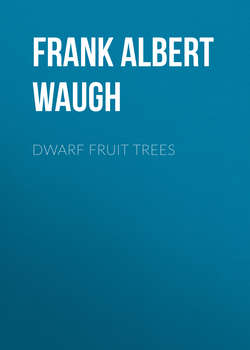Читать книгу Dwarf Fruit Trees - Frank Albert Waugh - Страница 5
II
ADVANTAGES AND DISADVANTAGES
SOME DISADVANTAGES
ОглавлениеThere are, of course, some disadvantages in growing dwarf fruit trees, and these should be examined with as much care as the advantages. The more important ones are as follows:
1. Greater expense.—The trees are somewhat harder to propagate, and therefore cost more. There is no general demand for them in America, so that they are carried by only a few nurseries and are not looked upon as staple goods even with those dealers; and on this account the price is necessarily increased. Thus each tree costs more than a similar tree of the same age and variety propagated in the usual way. But the greatest increase of expense comes from the fact that many more trees are required to plant the same area. There is often an advantage, as already argued, in planting more trees to the acre, but it costs something to gain this advantage. An acre of ground can be planted with thirty-five standard apple trees set thirty-five feet apart each way, and these trees will cost, roughly estimating retail prices at $12 a hundred, $4.20. To plant an acre to dwarf apple trees, setting them six feet apart each way, which is about as thick as these trees should ever be planted, will require 1,210 trees. Estimating the retail price roughly at $15 a hundred this would make the first cost $181.50—a considerably greater initial investment in the orchard.
2. The trees are shorter lived.—This statement is true for certain kinds of dwarf trees, but not for others. Certain varieties of pears, for example, which do not unite well with the quince root, naturally make short lived trees. On the other hand other varieties of pears appear to live as long and thrive fully as well on quince roots as on pear roots. There is a common belief, especially in England, that apples worked on French paradise roots are apt to be short-lived. The nurserymen who hold this belief contend, however, that the so-called English Paradise, more properly called Doucin, supplies a stock on which apples will live to as great an age as on any other stock whatever. There is some evidence to show that vigorous varieties of plums worked on Americana roots or on dwarf sand cherry are shorter lived than the same varieties on freer growing stocks. In many cases, however, dwarf trees live as long as standards; and in almost all cases they live long enough.
3. They require more care.—This objection stands particularly against the dwarf trees trained in special and intricate forms. Such trees undoubtedly do require more careful attention, more frequent going-over, and more hand work in the course of the year. It is probably not true that apples, pears, plums or peaches in bush or pyramid forms require any more labor or attention than standard trees to secure equally good results. On the other hand it must not be forgotten, as has already been pointed out, that whatever care may be required is much more easily given the dwarf trees than the standards.
4. They are not a commercial success.—This statement, too, though undoubtedly having some truth in it, can not stand without qualification. It is certainly true that no one could grow ordinary varieties of apples, like Baldwin or Ben Davis for instance, on dwarf trees in competition with men who are growing the same varieties on standards. It is probably true that fancy varieties of apples can be grown with profit on dwarf trees, but even this can not be strongly urged. So far as apples are concerned the chief value of dwarf trees for modern commercial enterprises in America will come through their use as fillers between rows of standard trees. In the case of pears the situation is somewhat more favorable to dwarf trees. There are a number of orchards in this country where pears have been successfully grown for market, these many years, on dwarf trees. The famous and everywhere planted Bartlett succeeds admirably on the quince stock wherever the soil is suited to it. No successful commercial orchards of dwarf peaches or plums can be cited in this country, individual trees of these kinds even being extremely rare; yet there is good reason to suppose that under favorable conditions dwarf peaches and plums may have some commercial value. Such value may be more in the way of supplementing standard trees than in superseding them, but it is still worth consideration. So that, after all, when we say that dwarf fruit trees are not a commercial success we mean merely that they will not take the place of standard trees. The large market orchards must always continue to be made up of standard trees; but in their own way the dwarf trees will find a limited place even in commercial operations, and this use of them seems destined to be more general in the future than it has been in the past.
